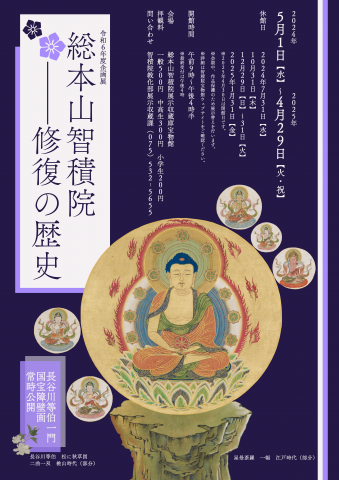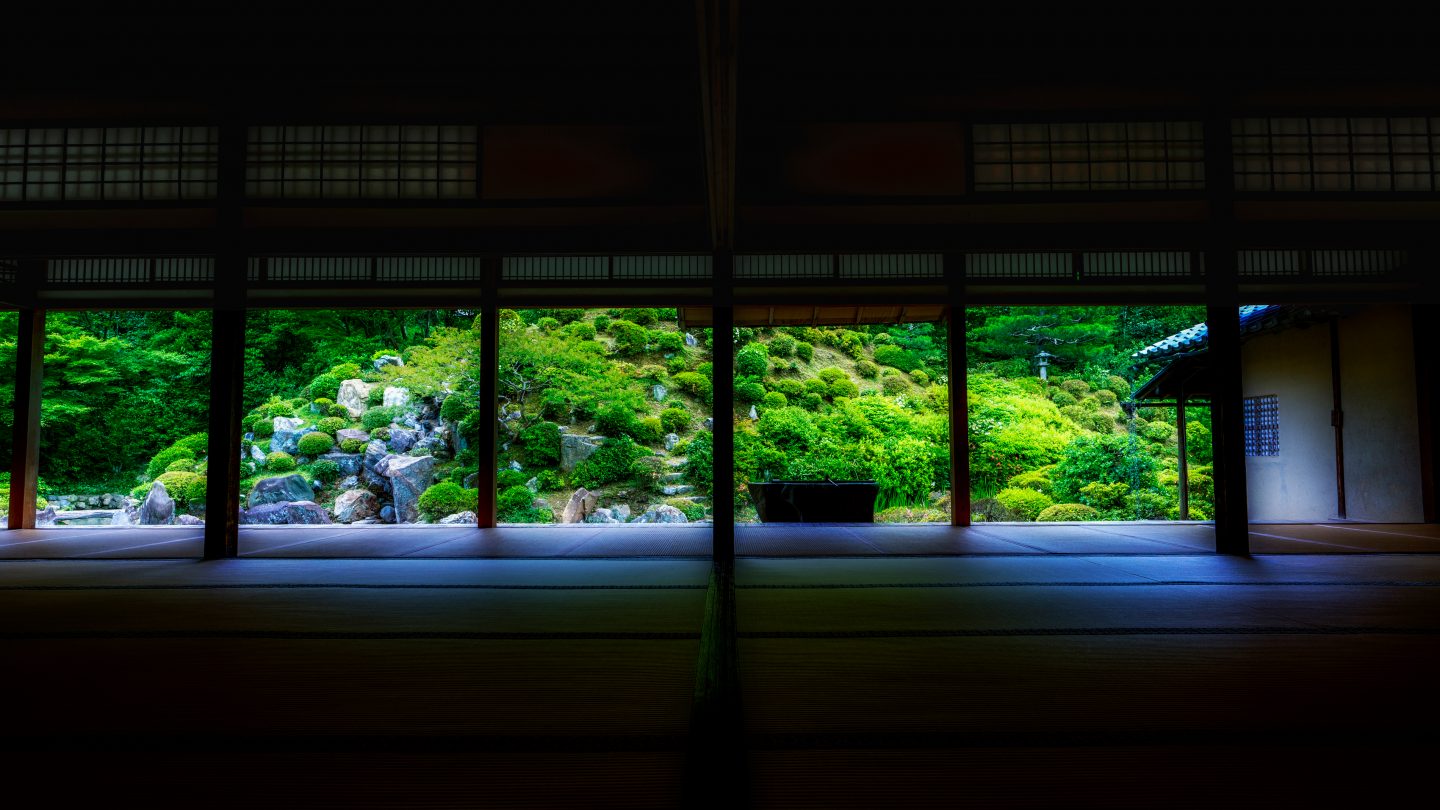About the 2024 special exhibition “the Main Head Temple Chishakuin – History of Restoration”
1.Exhibition theme: “the Main Head Temple Chishakuin – History of Restoration”

The National Treasure wall paintings currently housed in the Treasure Museum originally decorated the guest hall of Shounji Temple, and were handed over to Chishakuin Temple following the reception of Shounji Temple, where they have been carefully stored ever since. Although much of it was lost due to fires during the Edo and Showa periods and theft during the Meiji period, it still remains in its gorgeous appearance.
The wall paintings have been restored several times. Recent examples include the restoration of cherry blossoms, maples, yellow hollyhock on pine, autumn grass on pine, and snowy pine in the early Heisei era, and the restoration of standing hollyhock on pine between 2021 and 2020. In addition, to this day, pine and plum paintings are being added, different shelves are being added to the wall to decorate the Sanzan room of the Shinden, and the small sliding doors are being restored. The pine and hollyhock painting was exhibited at the treasure museum for the first time after its restoration, but the results of the research conducted during the restoration have not yet been made public.
In terms of restoration, not only the wall paintings, but also the materials remaining at Chishaku-in contain records of the history of restoration. Chishaku-in has undergone extensive restoration several times. During the two years of Kansei 10th and 11th (1798 and 1799), during the assembly, in 1775, the 22nd priest of Chishaku-in, Docho, In 1778, it was restored by Michimei, an expert advisor from the time of Docho Sojo, and in 1893, by the 44th head of Chishaku-in Temple, Takamoto Saeki. It is being done. Because such restoration was carried out regularly, the materials of Chishaku-in have been preserved to this day.
One of the basic philosophies of the Treasure Museum is to store its collection in an appropriate environment, in order to pass on the treasured materials to the next generation. However, no matter how well the materials are stored in the right environment, deterioration over time is unavoidable, and even now we are checking the damage to the materials and gradually repairing them before displaying and storing them.
This exhibition focuses on this concept of “restoration,” and is structured to give an overview of the history of restoration that has been carried out within Chishaku-in. In addition to the materials listed above that contain descriptions of large-scale restorations, we will exhibit materials that show that restorations have been carried out as appropriate depending on their condition. In addition, we will display the old parts that were removed during the restoration, such as the old quarters and base of the Matsu Tachiholois drawing, and we will also use exhibition graphics to introduce the results of the research that was carried out in connection with the restoration of the Matsu Tachihollyhocks drawing. Masu.
2.Exhibition period/exhibition materials
*National treasure wall paintings by Tohaku Hasegawa’s family will be on permanent display.
*In 2024, materials will be divided into Group A and Group B and exhibited alternately.
①May 1, 2024 – July 30, 2024
[Group A]
“Yuchi Seki” (Enpo 7th year (1679)), cover with danshi cover and tusk scroll
“Chishaku-in Reiho No. 4 Kesa Segu Catalog, Vol. 1” (Edo period)
“Taiyuan Mandala” (Edo period), colored silk, wooden scroll
“Thousand-Armed Kannon Statue” (Edo period), colored silk and gold scroll
“Statue of Fugen Enmei” (Edo period), painted silk and wooden scroll
“Forehead characters” (Edo period), paperback with ink calligraphy on wooden scroll
“Fudo Myoozu” (Muromachi period), colored silk, wood scroll
[All year]
“Picture and Hollyhocks, Old Shibuichi”
“Pine hollyhock drawing, old lining”
②August 1, 2024 to October 30, 2024
[Group B]
“Junyoze” (Edo period), cover with danshi mount
“Chishakuin Hogu Segu Catalog Volume 2” (Edo period)
“Star Mandala” (Edo period), colored silk, paulownia crest and gold scroll
“Statue of the 10th Priest” (Edo period, 1710), colored silk and gold scroll
“Deyama Shaka” (Edo period), paperback, colored silk and gold brocade mounting
“Jizo statue” (Nanbokucho period), colored silk with gold scroll
“Ietsuna Kosho” (Edo period), paperback, ink and silk, tusk scroll
[All year]
“Picture and Hollyhocks, Old Shibuichi”
“Pine hollyhock drawing, old lining”
③November 1, 2024 to January 30, 2025
[Group A]
“Yuchi Seki” (Enpo 7th year (1679)), cover with danshi cover and tusk scroll
“Chishaku-in Reiho No. 4 Kesa Segu Catalog, Vol. 1” (Edo period)
“Taiyuan Mandala” (Edo period), colored silk, wooden scroll
“Thousand-Armed Kannon Statue” (Edo period), colored silk and gold scroll
“Statue of Fugen Enmei” (Edo period), painted silk and wooden scroll
“Forehead characters” (Edo period), paperback with ink calligraphy on wooden scroll
“Fudo Myoozu” (Muromachi period), colored silk, wood scroll
[All year]
“Picture and Hollyhocks, Old Shibuichi”
“Pine hollyhock drawing, old lining”
④February 1, 2025 – April 29, 2025
[Group B]
“Junyoze” (Edo period), cover with danshi mount
“Chishakuin Hogu Segu Catalog Volume 2” (Edo period)
“Star Mandala” (Edo period), colored silk, paulownia crest and gold scroll
“Statue of the 10th Priest” (Edo period, 1710), colored silk and gold scroll
“Deyama Shaka” (Edo period), paperback, colored silk and gold brocade mounting
“Jizo statue” (Nanbokucho period), colored silk with gold scroll
“Ietsuna Kosho” (Edo period), paperback, ink and silk, tusk scroll
[All year]
“Picture and Hollyhocks, Old Shibuichi”
“Pine hollyhock drawing, old lining”

